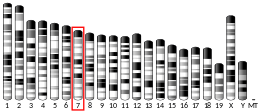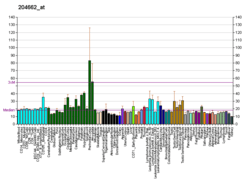CCP110
Centriolar coiled-coil protein of 110 kDa also known as centrosomal protein of 110 kDa or CP110 is a protein that in humans is encoded by the CCP110 gene. It is a cell cycle-dependent CDK substrate and regulates centrosome duplication.[5][6] CP110 suppresses a cilia assembly program.[7]
References
- GRCh38: Ensembl release 89: ENSG00000103540 - Ensembl, May 2017
- GRCm38: Ensembl release 89: ENSMUSG00000033904 - Ensembl, May 2017
- "Human PubMed Reference:". National Center for Biotechnology Information, U.S. National Library of Medicine.
- "Mouse PubMed Reference:". National Center for Biotechnology Information, U.S. National Library of Medicine.
- Chen Z, Indjeian VB, McManus M, Wang L, Dynlacht BD (September 2002). "CP110, a cell cycle-dependent CDK substrate, regulates centrosome duplication in human cells". Dev. Cell. 3 (3): 339–50. doi:10.1016/S1534-5807(02)00258-7. PMID 12361598.
- Li J, D'Angiolella V, Seeley ES, Kim S, Kobayashi T, Fu W, Campos EI, Pagano M, Dynlacht BD (March 2013). "USP33 regulates centrosome biogenesis via deubiquitination of the centriolar protein CP110". Nature. 495 (7440): 255–9. doi:10.1038/nature11941. PMC 3815529. PMID 23486064.
- Spektor A, Tsang WY, Khoo D, Dynlacht BD (August 2007). "Cep97 and CP110 suppress a cilia assembly program". Cell. 130 (4): 678–90. doi:10.1016/j.cell.2007.06.027. PMID 17719545.
External links
- Human CCP110 genome location and CCP110 gene details page in the UCSC Genome Browser.
Further reading
- Ishikawa K, Nagase T, Nakajima D, et al. (1998). "Prediction of the coding sequences of unidentified human genes. VIII. 78 new cDNA clones from brain which code for large proteins in vitro". DNA Res. 4 (5): 307–13. doi:10.1093/dnares/4.5.307. PMID 9455477.
- Loftus BJ, Kim UJ, Sneddon VP, et al. (1999). "Genome duplications and other features in 12 Mb of DNA sequence from human chromosome 16p and 16q". Genomics. 60 (3): 295–308. doi:10.1006/geno.1999.5927. PMID 10493829.
- Strausberg RL, Feingold EA, Grouse LH, et al. (2003). "Generation and initial analysis of more than 15,000 full-length human and mouse cDNA sequences". Proc. Natl. Acad. Sci. U.S.A. 99 (26): 16899–903. doi:10.1073/pnas.242603899. PMC 139241. PMID 12477932.
- Andersen JS, Wilkinson CJ, Mayor T, et al. (2003). "Proteomic characterization of the human centrosome by protein correlation profiling". Nature. 426 (6966): 570–4. doi:10.1038/nature02166. PMID 14654843.
- Gerhard DS, Wagner L, Feingold EA, et al. (2004). "The status, quality, and expansion of the NIH full-length cDNA project: the Mammalian Gene Collection (MGC)". Genome Res. 14 (10B): 2121–7. doi:10.1101/gr.2596504. PMC 528928. PMID 15489334.
- Zou C, Li J, Bai Y, et al. (2006). "Centrobin: a novel daughter centriole-associated protein that is required for centriole duplication". J. Cell Biol. 171 (3): 437–45. doi:10.1083/jcb.200506185. PMC 2171251. PMID 16275750.
- Tsang WY, Spektor A, Luciano DJ, et al. (2006). "CP110 cooperates with two calcium-binding proteins to regulate cytokinesis and genome stability". Mol. Biol. Cell. 17 (8): 3423–34. doi:10.1091/mbc.E06-04-0371. PMC 1525247. PMID 16760425.
- Beausoleil SA, Villén J, Gerber SA, et al. (2006). "A probability-based approach for high-throughput protein phosphorylation analysis and site localization". Nat. Biotechnol. 24 (10): 1285–92. doi:10.1038/nbt1240. PMID 16964243.
- Pearson CG, Culver BP, Winey M (2007). "Centrioles want to move out and make cilia". Dev. Cell. 13 (3): 319–21. doi:10.1016/j.devcel.2007.08.007. PMID 17765674.
This article is issued from Wikipedia. The text is licensed under Creative Commons - Attribution - Sharealike. Additional terms may apply for the media files.




